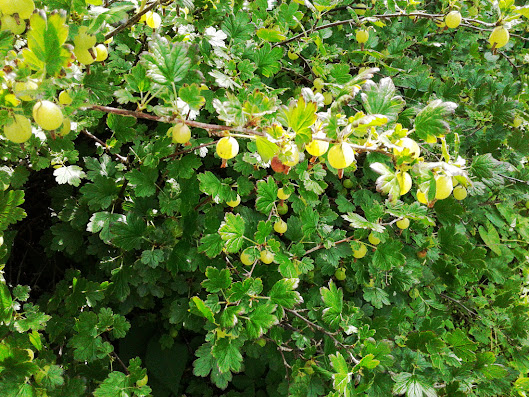In August there was a good harvest of gooseberries in the garden. There are thorns on the bush, and I tried not to hurt my hands, I usually wore a blouse with long sleeves. I try to lift the branch with my left hand and collect the gooseberries with my right. This way the branches prick less.
Maybe someone does not know this plant, so I want to tell you. Gooseberry is a small shrub up to 1-1.2 m high, the branches are grayish, covered with thin needle-like thorns. The fruits are berries, oval or spherical, up to 12 mm long (sometimes up to 30-40 mm), bristly. Green, yellow or dark red. Ripen in July–August.
Gooseberries are native to Western Europe and northern Africa. As a wild plant, it is widespread in Central and Southern Europe, North Africa and North America. It grows among bushes on rocky mountain slopes. It is grown everywhere in gardens.
The common gooseberry is one of the main berry bushes. I like to eat them fresh or use them to make jam, jelly, marmalade, and some people make wine from gooseberries. I also freeze gooseberries and they retain most of the vitamins. This is a good preparation for the winter.
When I pick gooseberries, I determine how ripe the gooseberries are, so I squeeze the berries. The ideal berry is not too hard, but retains its shape and elasticity. I have bushes growing with small red and yellow gooseberries. Small berries ripen earlier.
Currently, at least 1,500 varieties of gooseberries are known, which are cultivated in all temperate countries. Unfortunately, gooseberries are often attacked by pests.
Do you like to eat gooseberries? Have you grown this bush?
My video. Park roses:




I miss gooseberries. I love them. The fruit can be eaten raw or processed into jam or compote... I like them raw, picked straight from the bush.
ReplyDeleteHugs and greetings.
So do I, Lucja. Love eaten them from the bush.
DeleteYour gooseberry bushes looks very nice, Nadezda. I don't have any of them in my garden. The parkroses are very beautiful!
ReplyDeleteThank you Marit, glad you liked my new video.
DeleteI haven’t had gooseberries in years and just seeing them here incites a craving. I knew a woman who made an excellent gooseberry pie when I was a child and sometimes as a reward for doing cleanup chores around her garden she would give me a slice.
ReplyDeleteI see, David, you were a very hard worker as a child (and still are!), so this jam sandwich was a tasty reward.
DeleteMe gustan las grosellas. Tiene una linda flor. Te mando un beso.
ReplyDeleteGracias Сitu, me encanta comer grosellas y hacer mermelada.
DeletePicking gooseberries is certainly a painful task.
ReplyDeleteYou're right, Sue.
DeleteBoa tarde de segunda-feira e uma excelente semana. Obrigado pela visita e comentário. Infelizmente nunca conheci groselha 😢 😿 😢. Acho que não se adaptaria ao clima do Rio de Janeiro. Vontade de conhecer e provar uma.
ReplyDeleteLuis, por supuesto, las grosellas necesitan un clima con inviernos fríos. Quizás algún día pruebes la mermelada de grosella o sus bayas.
DeleteHerkullisen näköiset karviaiset ja ihanat ruusut. 😊
ReplyDeleteYes, Anemone. Love gooseberry and make jam.
DeleteMe encantan estas frutas. Yo las llamo uva crispa. Besos.
ReplyDeleteYo tambien, Teresa, gracias.
DeleteLovely photos of a delicious berry. We have gooseberry bushes and the berries, much like rhubarb, make any pie tastier. :)
ReplyDeleteThe rose video is wonderful too and you choose always a beautiful music for your videos.
Happy autumn days to you!
Sure, you have gooseberry in your garden, Sara. Thanks for the recipe, will make jam with rhubarb.
DeleteHi Nadezda,
ReplyDeleteInteresting and beautiful plant, both the leaves and the fruits. I had never seen it.
Your video is excellent 👏 Wonderful roses, I loved walking through this park. Thanks for sharing.
Greetings from Maria
I think you'll like the berries when you try them, Maria. Glad you liked my video!
DeleteI like gooseberries fresh from the bush or as a nice gooseberry cake.
ReplyDeleteI could also imagine making jam, but I never have enough berries for that.
I wish you a good week and beautiful autumn days.
Viola
Viola, I love gooseberry jam and always separate the juice from the solid parts of the berries. This makes the jam tastier. Hugs.
Delete